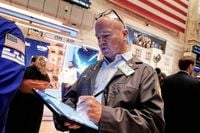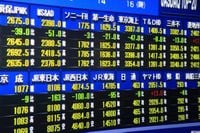Asian stock markets delivered a patchwork of results on Wednesday, August 27, 2025, reflecting a complex interplay of global economic forces, investor caution, and political intrigue. The day saw traders in the Asia-Pacific region grappling with mixed signals from Wall Street, fresh data on China’s industrial sector, and the looming impact of U.S. tariffs on India and China. Meanwhile, the world’s financial eyes remained fixed on Washington, where President Donald Trump’s escalating feud with the Federal Reserve and his aggressive tariff policies sent ripples across global markets.
According to MG News, Asian markets diverged from Wall Street’s upbeat tone as investors assessed China’s latest industrial profits data. In July, China’s industrial profits slipped 1.5% year-over-year, marking a recovery from months of sharper declines. While a drop is never good news, the smaller-than-expected contraction was interpreted as a hopeful sign for the world’s second-largest economy. Still, traders remained wary, with the mainland CSI 300 index snapping its four-day winning streak but holding onto a 0.4% gain for the day. Notably, the CSI 300 has climbed over 13% so far in 2025, prompting Nomura and other banks to warn of “irrational exuberance.” Hao Hong, managing partner and CIO of Lotus Asset Management, told MG News, “Sentiment is becoming excessively optimistic,” while cautioning that it’s “too early” to call the market a bubble. He added, “Given the improving liquidity conditions and a dovish Fed, any correction will tend to be shallow and brief.”
Elsewhere in Asia, the mood was equally mixed. The Nikkei 225 in Japan nudged higher, buoyed by a dramatic surge in Nikon Corporation shares—up nearly 21% as of late Tuesday, after Bloomberg reported that EssilorLuxottica, the Ray-Ban maker, was considering raising its stake in the company. The broader Topix index, however, slipped 0.3%. South Korea’s Kospi and Kosdaq both fell for a second consecutive session, down 0.17% and 0.16% respectively. Australia’s S&P/ASX 200 bucked the regional trend, adding 0.15%, with mining and financial stocks leading the way. According to RTTNews, BHP Group gained more than 1%, Mineral Resources surged almost 5%, and Rio Tinto added almost 1%. Gold miners also sparkled, with Evolution Mining and Resolute Mining up roughly 3% or more. Yet not all was rosy: Woolworths shares plunged nearly 14% after the supermarket giant slashed its final dividend by over 21% and posted a 17% drop in net profit for the year.
Hong Kong’s Hang Seng index rose 0.27%, and the mainland CSI 300’s modest gain was enough to break its recent winning streak. In currency markets, the Australian dollar traded at $0.649, while the U.S. dollar hovered in the higher 147 yen-range. Asian markets had closed mostly lower on Tuesday, reflecting a cautious mood ahead of key U.S. economic data releases later in the week, including second quarter GDP and the Federal Reserve’s preferred inflation readings.
Australia’s economic indicators painted a picture of modest momentum. The Consumer Price Index jumped 2.8% year-over-year in July, the highest reading since July 2024 and well above June’s 1.9%. Trimmed mean inflation rose to 2.7%, while core inflation excluding volatile items and travel accelerated to 3.2%. Construction activity rebounded strongly in the second quarter, rising 3% quarter-on-quarter and 4.8% year-on-year. Still, the Westpac-Melbourne Institute Leading Economic Index only edged up 0.1% in July, and Westpac projects GDP growth of 1.7% for 2025—better than last year’s 1.3%, but still below the long-term trend. Westpac expects the central bank to hold rates steady in September before delivering a 25-basis-point cut in November.
On Wall Street, the mood was cautiously optimistic. The S&P 500 rose 0.41% to close at 6,465.94, the Nasdaq Composite added 0.44% to finish at 21,544.27, and the Dow Jones Industrial Average gained 135.60 points, or 0.30%, to end at 45,418.07. According to the Associated Press, investors were eagerly awaiting Nvidia’s quarterly report, widely seen as a bellwether for the artificial intelligence boom. Nvidia shares were up 0.1% ahead of the report. Technology and financial companies led the charge, offsetting declines in sectors like healthcare and communications. Several companies delivered strong earnings: Kohl’s soared 17.4% and MongoDB surged 34.9% after both beat analyst forecasts and raised their full-year guidance. Abercrombie & Fitch edged up 0.4% on better-than-expected results, while J.M. Smucker tumbled 5.1% after missing estimates. Cracker Barrel’s shares climbed 8.3% after the company reversed a controversial logo change following a social media uproar that even drew a comment from President Trump.
But it wasn’t all smooth sailing in the U.S. political sphere. President Trump’s decision to remove Federal Reserve Governor Lisa Cook from the central bank’s board sent shockwaves through financial circles. Trump, who has long feuded with the Fed over its interest rate policy and threatened to fire Chair Jerome Powell, accused Cook of making false statements on mortgage agreements. Cook, for her part, insisted Trump lacked the authority to fire her and vowed to challenge the move in court. “I will not resign,” Cook declared, adding she would file a lawsuit to contest her removal. The Federal Reserve, for its part, said it would “abide by any court decision.”
Trump’s aggressive trade tactics were also on display. Steep new U.S. tariffs on India—imposed in response to India’s purchases of Russian oil—took effect Wednesday, pushing the total tariffs on Indian exports to the U.S. to 50%. Indian markets were closed for a holiday, but the move underscored growing tensions between Washington and its allies. Trump has also threatened “substantial additional tariffs” on countries that don’t remove digital taxes targeting U.S. tech companies, and even floated the idea of 200% tariffs on China if Beijing refuses to export rare-earth magnets to the U.S.
Bond markets reflected the uncertainty. The yield on the 10-year Treasury rose to 4.27% from 4.26% a day earlier, while the two-year Treasury yield—closely watched for Fed policy expectations—slipped to 3.64%. Traders remain convinced the Fed will cut rates by a quarter-point at its September meeting, with CME Group data showing a 90.3% probability. The Fed last cut rates in late 2024, after years of fighting inflation, but has since held steady amid concerns that Trump’s unpredictable tariff policies could reignite price pressures. Friday will bring the next big data point: the U.S. personal consumption expenditures index, with economists expecting July inflation to remain at about 2.6% year-over-year.
European markets, meanwhile, were mostly lower, with France’s CAC 40 down 1.7%, the UK’s FTSE 100 off 0.6%, and Germany’s DAX down 0.5%. Crude oil prices were volatile, with West Texas Intermediate crude for October delivery falling sharply on Tuesday, only to rebound on Wednesday as traders digested the latest twists in U.S. trade policy.
In sum, Wednesday’s trading session offered a vivid snapshot of a world economy in flux: buoyant in some corners, cautious in others, and always at the mercy of shifting political winds. Investors are left to navigate a landscape where the only constant is uncertainty—and where tomorrow’s headlines could once again upend today’s market logic.





